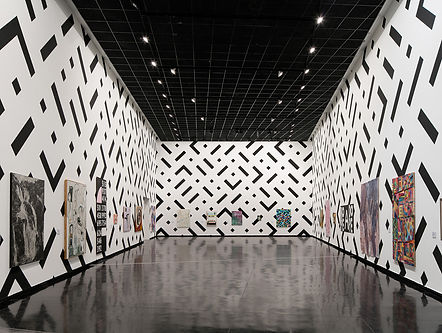‘Painting. More Painting',
Frieze, No. 184, January-February 2017,
Sophie Knezic

Painting. More Painting
Australian Centre for Contemporary Art (ACCA)
30 July – 2 August; 2 – 25 September, 2016
When ACCA was launched in 1984 in a repurposed gardener’s cottage in Melbourne’s Royal Botanic Gardens, three local artists were invited to each occupy a room and paint it as they liked. The result was a series of murals that spoke of the free-form liveliness and prevalence of painting as the favoured artistic mode of the era. Fast-forward 32 years and for the first time since that inaugural show ACCA has reprised the curatorial remit of an exhibition pivoting on painting – to very different ends.
Conceived by the curators Annika Kristensen and Hannah Mathews (and steered by ACCA’s artistic director Max Delany), the objective was to mount the first national survey of contemporary painting in an Australian museum for a decade, redress the lack of attention ACCA has granted to the medium and present a spectrum of current strains in painting practice drawn from a range of early, mid-career and senior artists.
Expansive and rambling, ’Painting. More Painting’ took place over two instalments and featured a total of 79 Australian artists. Its curatorial strategy oscillated perilously between neutrality and command, misguidedness and masterstroke. The exhibition was divided into two parts corresponding to the gallery architecture: one offered a concentrated focus on a body of work by seven artists (‘solo presentations’) while the other presented a more general survey of approximately 30 artists, alphabetically arranged (the ‘panorama’). This schema was then multiplied twice, resulting in two iterations of the exhibition (the ‘chapters’).
The solo presentations were the high point: an astute selection of mature artists whose dedicated exploration of the medium has yielded distinctive results. These included David Jolly’s enigmatic and subtle paintings on glass of hipster raves in the rural landscape, Mitch Cairns’s crisp and comic choreographies of suburban objects and Diena Georgetti’s faux-modernist collage abstractions. Stephen Bram’s low-slung, wide-screen canvas of an architectural-geometric abstraction emblematic of his signature style, Untitled (two point perspective) (2016), was a standout.
The most controversial aspect of ‘Painting. More Painting’ was the decision to grant Sam Songailo the liberty of covering the main gallery housing the ‘panorama’ with a floor-to-ceiling wall painting, Sorry to kill the vibe, but time does exist (2016). Black diagonal beams criss-crossed the soaring eleven-metre high walls and acted as the backdrop for the paintings. Recalling the work of the Italian artist Esther Stocker, the lattice was intended as a structural device linking the paintings in the manner of a mesh or network, loosely referring to both modernist abstraction and digital space. But the modestly scaled paintings were dwarfed by the magnitude of the backdrop, and although a few works – such as Janet Burchill’s Collected Works of Emily Dickinson (515 circumference) (2016) – responded well to the context, many of the more subtle inclusions were overpowered by the boldness of Songailo’s design.
The rationale for why certain artists were granted a solo presentation while others were hung in the ‘panorama’ was never clear. Some of the more established artists such as Nadine Christensen, Juan Davila, Jan Nelson and Rose Nolan could easily have featured in the solo presentations, which suggests that the curatorial discussions over which artist was directed where must have been intense and contestatory.
The attenuated debates over painting’s post-medium condition were largely ignored in this survey: the curators chose artists whose material affiliation with painting remained tethered to a mostly traditional definition, i.e. pigment in a liquid binder manually applied to a canvas support. Far from being a predictable survey of a stalwart medium, ‘Painting. More Painting’ proved that painting is not only capable of eliciting strong reactions but is being explored from myriad directions – and as a result, curatorial decisions around its display can be fraught, memorable and provocative.
Image caption:
Installation view, Panorama: A-M, 30 July – 28 August, 2016, ACCA